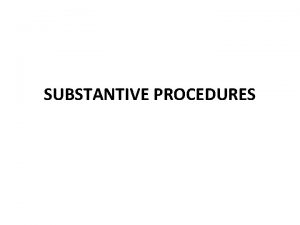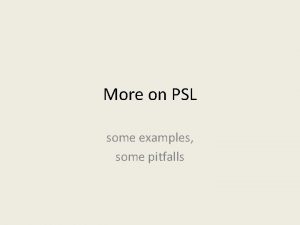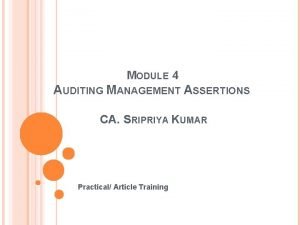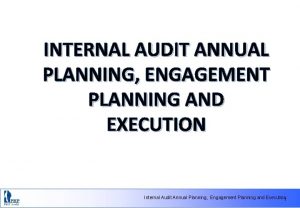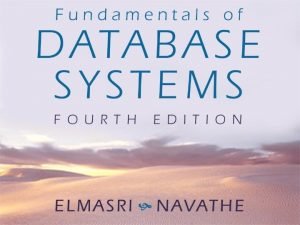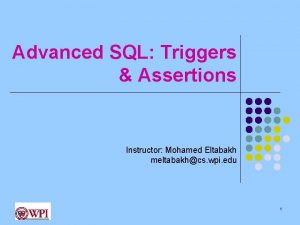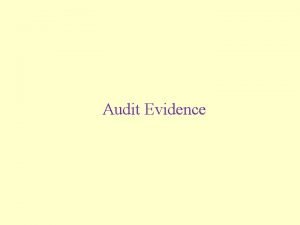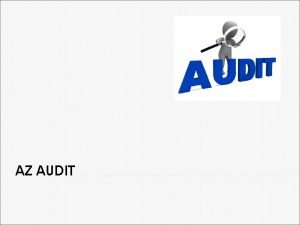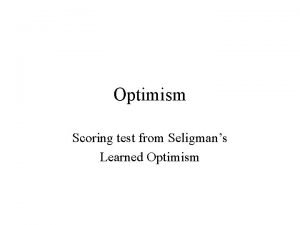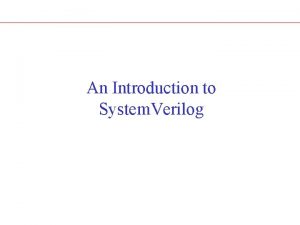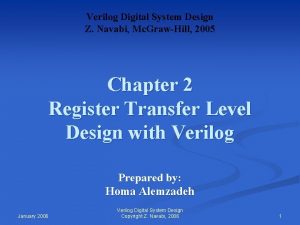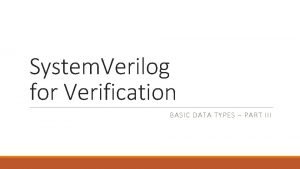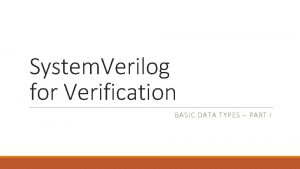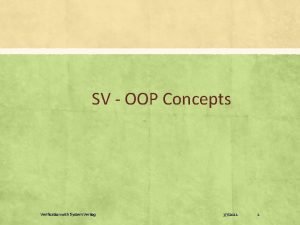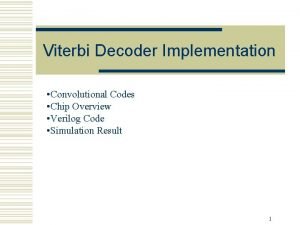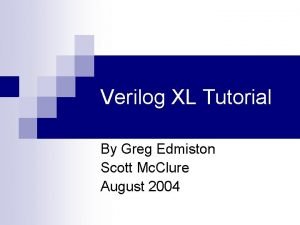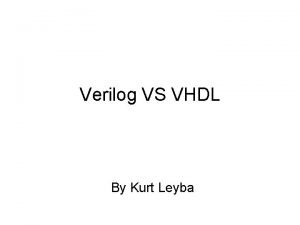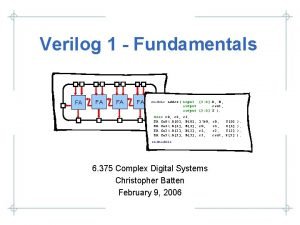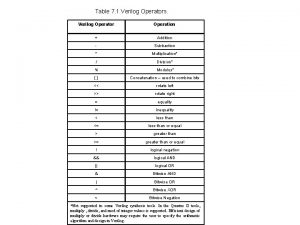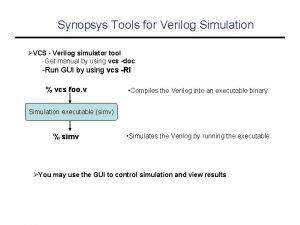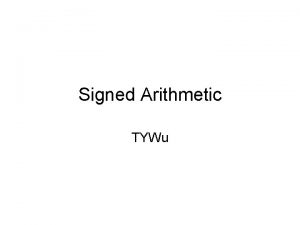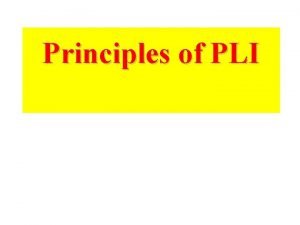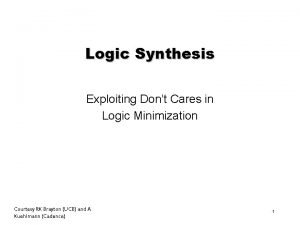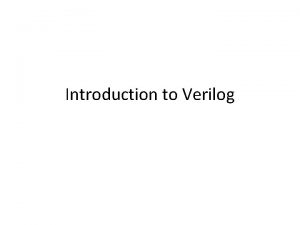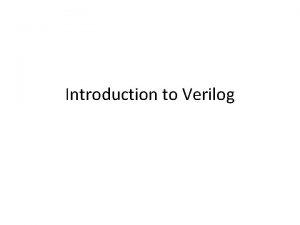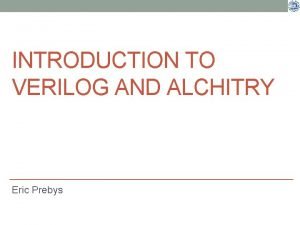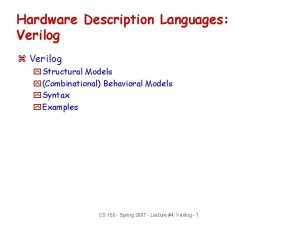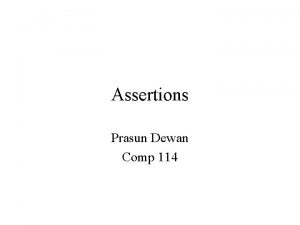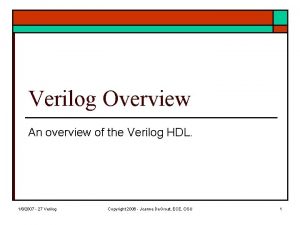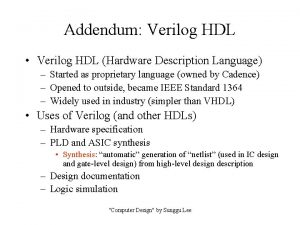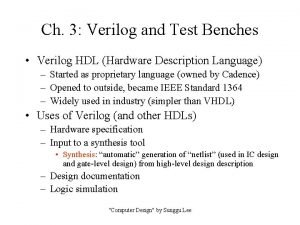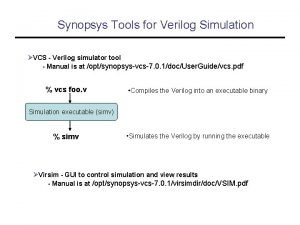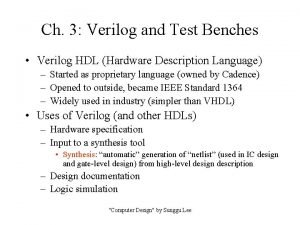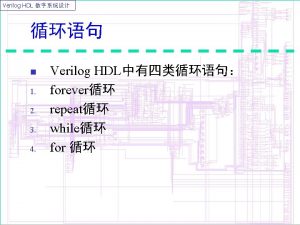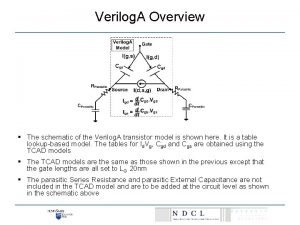Introduction to System Verilog Assertions Erik Seligman CS






















![Other Useful Building Blocks § In bounds, ‘$’ = infinity foo[*3: $] ##1 bar Other Useful Building Blocks § In bounds, ‘$’ = infinity foo[*3: $] ##1 bar](https://slidetodoc.com/presentation_image/00ce11a132372a5ce111fcc3423e0f51/image-23.jpg)





![Property Examples foo |=> bar foo ##1 bar |-> baz foo [*5] |-> not Property Examples foo |=> bar foo ##1 bar |-> baz foo [*5] |-> not](https://slidetodoc.com/presentation_image/00ce11a132372a5ce111fcc3423e0f51/image-29.jpg)

















- Slides: 46

Introduction to System Verilog Assertions Erik Seligman CS 510, Lecture 8, January 2009

Agenda § § § Introduction: What Is An Assertion? SVA Overview Boolean Layer Sequence Layer Property Layer Gotchas

Agenda § § § Introduction: What Is An Assertion? SVA Overview Boolean Layer Sequence Layer Property Layer Gotchas

What is an Assertion? § Statement about your RTL § “Executable Comment” § Usable both in simulation and formal • Simulation: check if vectors obey • Formal: mathematically prove

Who Creates Assertions? § RTL Authors • Recommend: enable/teach to all designers • Write assertions during RTL creation • Part of design process, like comments § Validators • Include assertions in testplans § FEV • Create assertions for FEV constraints

Other Assertion Statements § Assumptions • = Assertion used as FPV constraint • In simulation treated like regular assert § Cover point (“Anti-Assertion”) • Condition you want to see in some test • Useful for checking completeness of env – Simulation: monitor cumulative coverage of tests – Formal: make sure covers reachable under constraints § General term “assertion statement” includes assumes and covers • To avoid long-windedness in discussions

Agenda § § § Introduction: What Is An Assertion? SVA Overview Boolean Layer Sequence Layer Property Layer Gotchas

SVA Assertion Language § Part of p 1800 System. Verilog Standard • SVA popular even if SV not used for design § This lecture covers 2005 syntax • Currently implemented in most tools • 2009 syntax improves, but not official yet! § SVA assertions are part of language • May include in design, or ‘bind’ external file • Assertions appear within module

Types of SVA Assertions § Immediate assertions A 1: assert (foo && bar || baz); • Boolean only, no clocks or reset • Usable in arbitrary procedures, functions § Concurrent assertions A 2: assert property (@(posedge clk) disable iff (rst) (foo ##1 bar |=> baz)); • Full use of sequences & properties • Limited legal locations in procedural code • Usable outside procedures

Clocks and Resets § Feature of concurrent assertions § Clocks can be explicit, or • May inherit from default clocking statement default clocking @(posedge clk) endlocking; • May inherit from enclosing always @(posedge clk …) § Reset (‘disable iff’) explicitly, or • May inherit from enclosing always @(posedge clk or posedge rst) … • No default for reset, but added in SVA 2009

Assumes and Covers § Only for concurrent assertions • Immediate assume/cover added in 2009 § Change ‘assert’ keyword § Examples AS 1: assume property (@(posedge clk) disable iff (rst) (foo ##1 bar |=> baz)); C 1: cover property (@(posedge clk) disable iff (rst) (foo ##1 bar ##1 baz));

SVA assertion layers

Comments on Layers § § Booleans: simple expressions Sequences: set of booleans over time Properties: implications of sequences Assertion statements: actual usage in code • Bool, seq, prop does nothing unless in an assertion statement – Immediate: assert <bool> – Concurrent: assert property…, assume property…, cover property…

Agenda § § § Introduction: What Is An Assertion? SVA Overview Boolean Layer Sequence Layer Property Layer Gotchas

SVA assertion layers

Boolean Expressions in Assertions § Just use directly § Immediate Assertion a 1: assert (foo && bar || baz); • Checked when reached in code § Concurrent assertion a 2: assert property (foo && bar || baz); • Checked at each clock

Examples in context always @(*) begin // watch out for glitches! a 1: assert (foo && bar || baz); end always @(posedge clk) begin a 2: assert property (foo && bar || baz); end default clocking @(posedge clk 2); endclocking; // Is a 3 equivalent to a 2? a 3: assert property (foo && bar || baz);

Agenda § § § Introduction: What Is An Assertion? SVA Overview Boolean Layer Sequence Layer Property Layer Gotchas

SVA assertion layers

Sequences § Usable only in concurrent assertion § Inherit clock from usage • Default clocking / procedure clock • Or clock of property that uses § Basic sequence operations • s 1 ##[m: n] s 2: delay <m>to<n> cycles (0 = overlap) • s 1[*m: n]: repeat from <m> to <n> times • s 1 or s 2: one sequence is true • s 1 and s 2: same start, both eventually true – s 1 intersect s 2: must both end on same cycle • bool throughout s 1: bool true for all of s 1

Sequence Examples foo ##1 bar ##1 baz (foo ##1 bar) or (foo ##1 baz) (foo ##1 bar)[*5] ##1 baz foo throughout (bar[*5] ##1 baz)

Sequence Examples foo ##1 bar ##1 baz § foo, then bar, then baz (foo ##1 bar) or (foo ##1 baz) § foo, then either bar or baz (foo ##1 bar)[*5] ##1 baz § foo bar 5 times, then baz foo throughout (bar[*5] ##1 baz) § foo = 1 during (bar 5 times and then baz)
![Other Useful Building Blocks In bounds infinity foo3 1 bar Other Useful Building Blocks § In bounds, ‘$’ = infinity foo[*3: $] ##1 bar](https://slidetodoc.com/presentation_image/00ce11a132372a5ce111fcc3423e0f51/image-23.jpg)
Other Useful Building Blocks § In bounds, ‘$’ = infinity foo[*3: $] ##1 bar § Special system functions $past(sig) $rose(sig) $fell(sig) $stable(sig)

Named Sequences sequence s 1(a); a ##1 foo; endsequence § Then the following are equivalent a 1: assert property (s 1(bar) |-> baz) a 2: assert property ((bar ##1 foo) |-> baz));

Asserting a Sequence § What does this mean? assert property (foo ##1 bar); § Checks the sequence *every cycle* • Usually not useful! • Also expensive in simulation • Sequences mainly to help build properties § Negated sequence is very useful assert property (not(foo ##1 bar));

Agenda § § § Introduction: What Is An Assertion? SVA Overview Boolean Layer Sequence Layer Property Layer Gotchas

SVA assertion layers

Creating Properties § Basic operation: triggered implication seq |-> prop // overlapping seq |=> prop // non-overlapping § Trigger must be a sequence • Corresponds to intuition • Easy to check in simulation
![Property Examples foo bar foo 1 bar baz foo 5 not Property Examples foo |=> bar foo ##1 bar |-> baz foo [*5] |-> not](https://slidetodoc.com/presentation_image/00ce11a132372a5ce111fcc3423e0f51/image-29.jpg)
Property Examples foo |=> bar foo ##1 bar |-> baz foo [*5] |-> not (bar ##1 baz) foo ##0 bar |-> $rose(baz)

Property Examples foo |=> bar § If we see foo, we see bar the next cycle foo ##1 bar |-> baz § If we see foo and then bar, we also see baz (same cycle as bar) foo [*5] |-> not (bar ##1 baz) § If we see foo 5 times, then if bar is true during the 5 th, baz will be false next cycle foo ##0 bar |-> $rose(baz) § If foo and bar are true at the same time, baz must have just risen

Named Properties § Similar to named sequences property p 1(e 1, e 2); e 1 |=> e 2; endproperty § The following are equivalent: • assert property (p 1(foo, bar)); • assert property (foo |=> bar);

Property operators § AND, OR, NOT available • Don’t confuse with boolean &&, ||, ! § Some examples: assert property (a |-> b) AND (a |-> c); assert property (NOT (a ##1 b)); assert property (p 1(a, b) OR (a |-> b));

Other Useful Building Blocks § $onehot ( expr ) • true if exactly one bit of the expression is high § $onehot 0 ( expr ) • true if at most one bit of the expression is high. § $isunknown (expr ) • true if any bit of expression is (4 state logic) X or Z. § $countones ( expr ) • counts the number of bits set in a bit vector

Agenda § § § Introduction: What Is An Assertion? SVA Overview Boolean Layer Sequence Layer Property Layer Gotchas

Immediate Assertions Are Glitchy! always @(a or b) a 1: assert (a==b); always @(a) b = a; § What is order of always blocks? • Can a 1 be evaluated twice?

Immediate Assertions Are Glitchy! always @(a or b) a 1: assert (a==b); always @(a) b = a; § What is order of always blocks? • Can a 1 be evaluated twice? Yes! • Order of blocks not defined in Verilog / SV • Solution in SVA 2009 (“deferred assertion”), but not there yet… Don’t use immediate assertions unless really needed! • If you have clock, why not use it: A 1: assert property (@(posedge clk) (a==b));

Watch Those Parentheses § SVA syntax is fussy • Legal: assert property (foo |=> bar); • Illegal: assert property foo |=> bar; § Good idea to group anyway • Extra layer of () usually can’t hurt • Why depend on order of ops?

AND vs INTERSECT § Two similar sequence ops § AND = same start seq 1 seq 2 § INTERSECT = same start and end seq 1 seq 2

Sequences vs Properties § A sequence is a property… BUT • The property is “sequence matched starting every cycle” • Don’t confuse “a ##1 b” (continuously checked) with “a |=> b” (only checked when a is true) – Exception: initial block § assert property @(posedge clk) (foo ##1 bar); // Useful? == foo is always true, and so is bar starting on cycle 2 Negated Sequences are properties, not sequences “This sequence is never matched” Sometimes useful– but remember, it’s no longer a sequence

Sequences vs Properties § A sequence is a property… BUT • The property is “sequence matched starting every cycle” • Don’t confuse “a ##1 b” (continuously checked) with “a |=> b” (only checked when a is true) – Exception: initial block § assert property @(posedge clk) (foo ##1 bar); // Useful? == foo is always true, and so is bar starting on cycle 2 § Negated Sequences are properties, not sequences • “This sequence is never matched” • Sometimes useful– but remember, it’s no longer a sequence

Be Careful With $stable, etc § $stable, $changed, $past see previous values § But what is “previous” at start of sim? • Default value for type, often X § So what does this property do? wire foo; A 1: assert property ($stable(foo)) A 1 claims foo is always X! Rethink property, add delay or reset Safer version: A 2: assert property (##1 $stable(foo));

Be Careful With $stable, etc § $stable, $changed, $past see previous values § But what is “previous” at start of sim? • Default value for type, often X § So what does this property do? wire foo; A 1: assert property ($stable(foo)) • A 1 claims foo is always X! • Rethink property, add delay or reset § Safer version: A 2: assert property (##1 $stable(foo));

Triggered Implication § How to read a |-> b? • “a implies b”? Not exactly. • “a triggers b”: Better! § Some consequences of this definition • Left side must be a sequence, not a property • Negated sequence cannot be the left side – Negated sequence is property, not sequence! • If you want a negated sequence to trigger property, need to rethink – assert property (!s 1) |-> p 1; // illegal – assert property (p 1 or s 1); // OK… but different

Negating Properties § What does not (a |-> b) mean? • Doesn’t mean: b never happens when a does • Does mean: sometime, a happens and b doesn’t § Discuss using followed-by (#-#) operator • not(a |-> b) rewritten as a #-# not b • Read as “At some point, ‘a’ is followed by ‘!b’”. • #-# not in language yet– don’t use in code! – Another 2009 extension

Make Assertions Part of the Design Process § Define standard assertion note // Assertion a 123: Check for legal grants; § Designer adds: spec, testplans, RTL • Assertion idea != interrupt thought flow • OK to add note if no time to write assertion § Assertion expert role • Scripts to collect assertion notes • Help designer implement/focus § Assertions: casual & easy • Pitfall: Treat as “out-of-band” process • Pitfall: Avoid requirements seen as penalty – “Must eventually prove X% formally”

References / Further Reading • http: //www. chipdesignmag. com/display. php? article. Id=1448&issue. Id=23 • http: //www. doulos. com/knowhow/sysverilog/tutorial/assertions/ • http: //www. cadence. com/rl/Resources/application_briefs/Vhowto_SVA_E • • Z_Start. Guide. pdf http: //www. toomuchsemi. com/Docs 1/SVAOverview. pdf https: //www. syosil. com/files/publications/bsnug 04_ecker_esen_kruse_ste ininger_jensen. pdf? PHPSESSID=fdcf 823 af 22 a 7 c 9 f 4 bddfa 13 b 8646915
 Erik seligman
Erik seligman Sva $stable
Sva $stable Substantive procedures in audit
Substantive procedures in audit Psl assertions examples
Psl assertions examples Management assertions definition
Management assertions definition Types of internal control
Types of internal control Ceavop assertions
Ceavop assertions Sql assertions
Sql assertions Balance sheet assertions
Balance sheet assertions Triggers and assertions
Triggers and assertions General audit procedures
General audit procedures Audit assertions
Audit assertions Audit assertions
Audit assertions Biological preparedness
Biological preparedness Martin seligman kerry mueller
Martin seligman kerry mueller Teoria do desamparo aprendido
Teoria do desamparo aprendido Seligman learned optimism test
Seligman learned optimism test Nikki seligman
Nikki seligman Cole hasser
Cole hasser Authentic happiness.org
Authentic happiness.org Task and function in verilog
Task and function in verilog Introduction to systemverilog
Introduction to systemverilog Digital system design using verilog
Digital system design using verilog System verilog union
System verilog union Wand differs from wor in the way
Wand differs from wor in the way Systemverilog object oriented programming
Systemverilog object oriented programming Viterbi decoder verilog code
Viterbi decoder verilog code Greg edmiston
Greg edmiston Verilog hdl vs vhdl
Verilog hdl vs vhdl Site:slidetodoc.com
Site:slidetodoc.com Verilog quick reference
Verilog quick reference Verilog if문
Verilog if문 Non synthesizable constructs in verilog
Non synthesizable constructs in verilog Verilog
Verilog Verilog operator
Verilog operator Synopsys verilog simulator
Synopsys verilog simulator 16 bit divider verilog code
16 bit divider verilog code Signed addition verilog
Signed addition verilog Shift register
Shift register Verilog pli
Verilog pli Set less than alu
Set less than alu Verilog dont care
Verilog dont care Verilog structure
Verilog structure Verilog data types
Verilog data types Intro to verilog
Intro to verilog If statement verilog
If statement verilog Transport delay verilog
Transport delay verilog


